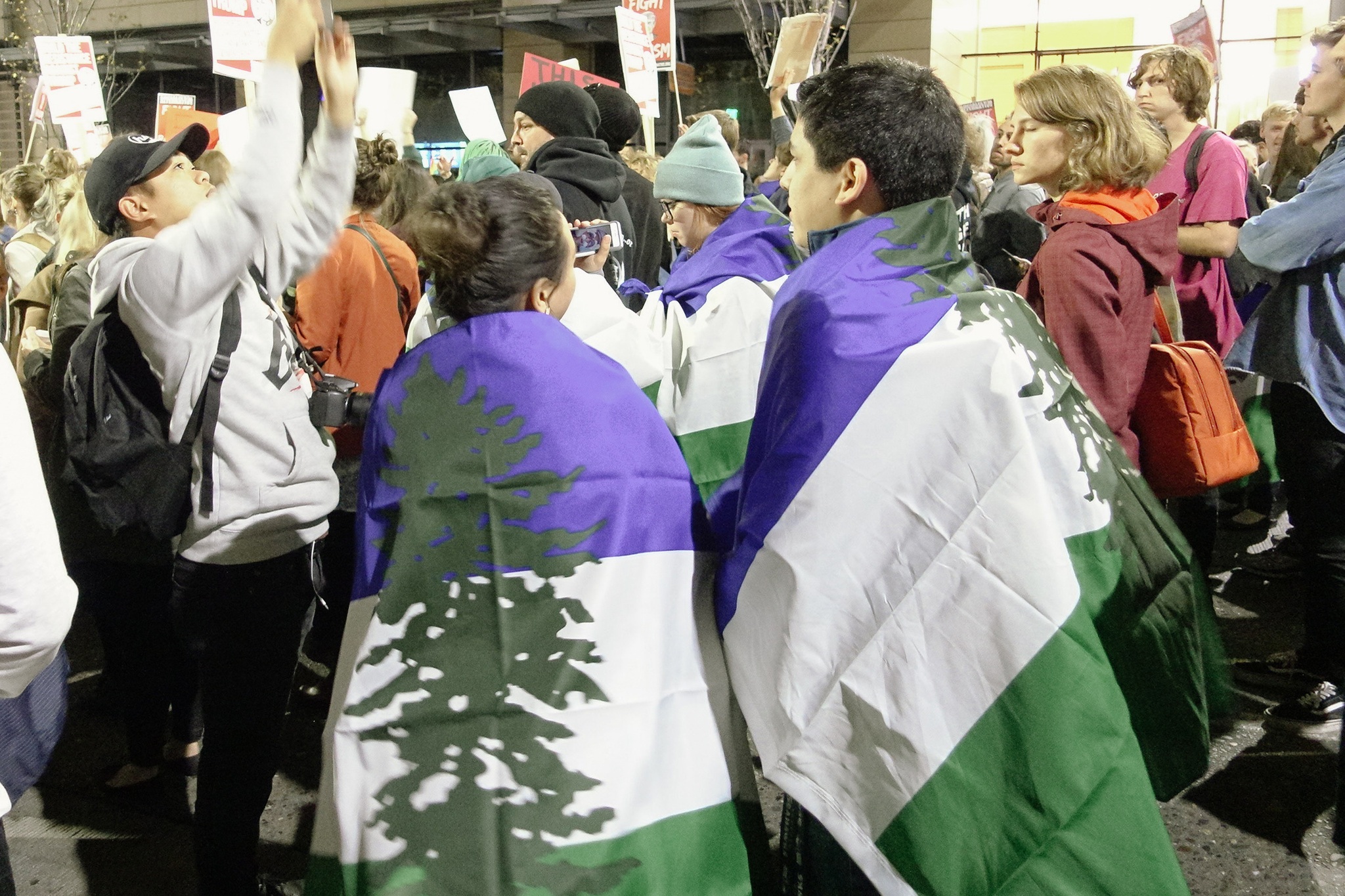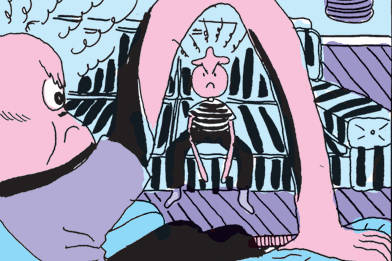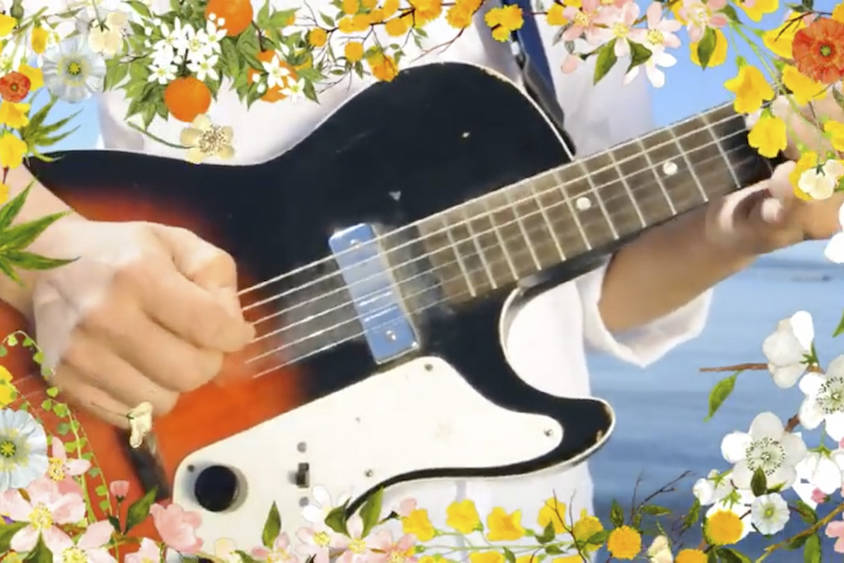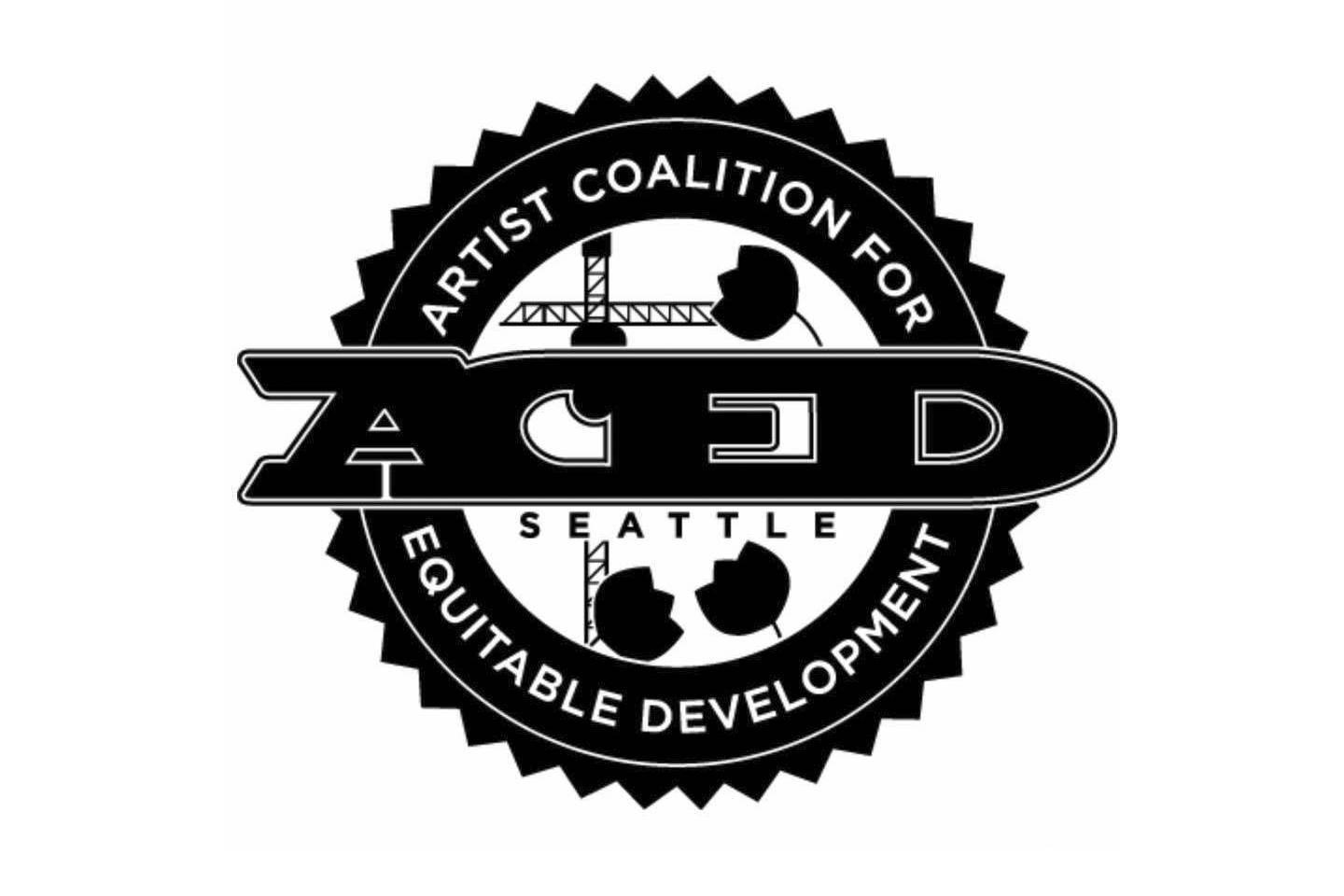On Friday, CascadiaNow executive director Brandon Letsinger met me next to some shipping crates in the parking lot of a marine warehouse on Ballard’s Salmon Bay.
“Here it is!” he said, walking me around the crates’ plank-strewn interior—the site of his 501(c)3 charitable nonprofit’s new offices, currently under construction.
“And over there,” he said, gesturing toward the lot, “is the Cascadia bus.” Painted green, blue, and white with a Douglas fir silhouette on the side—a riff on the design of the Cascadian Doug flag—Letsinger would spend the day preparing the bus for an upcoming trip to Standing Rock, N.D.
Two days before Donald Trump became the president-elect of the United States, CascadiaNow partnered with The Backbone Campaign and storyteller Paul Che oke ten Wagner of Vancouver Island’s Saanich tribe to answer a call from the Sacred Stone Camp. Preparing to buckle down for a long winter resisting the construction of the Dakota Access Pipeline, the indigenous water protectors asked for new campers able to stay through the cold months, along with a number of basic provisions. CascadiaNow and The Backbone Campaign chose 50 volunteer campers from the list of 100 they gathered, all of whom have now safely delivered to the camp one ton of medical supplies, resources, and tools—as well as 28 winterized tipis of Wagner’s design that will shelter 336 people.

The Cascadia Bus at Standing Rock. Courtesy CascadiaNow
On their own, these preparations would’ve made for a busy week for Letsinger. But then Trump won the election. Since the results rolled in, “we’ve had more than 100,000 hits on the CascadiaNow website, 273,000 on the [Cascadia] Wikipedia page, along with nearly 300 new members and volunteers,” Letsinger tells me, “one of the biggest spikes in interest we’ve ever seen.” Propelled by that momentum, on November 19 people interested in building a political Cascadian movement in Seattle and Portland will be getting together to answer a very important question: What does a “Cascadian movement” actually look like?
If you live in the Pacific Northwest, chances are you’ve seen the Cascadian Doug flag somewhere. Since its creation in 1994 by a geopolitics, cultural geography, and regional studies teacher from Portland named Alexander Baretich, the flag has found its way into regional MLS games; onto hats, T-shirts, and the labels of various local craft-brewed beers; into a wide array of political protests and actions (including recent anti-Trump marches in Seattle and Portland); and, in sticker and button form, onto countless walls, telephone poles, newspaper boxes, bathroom stalls, bike helmets, backpacks, and coat lapels. That’s in part thanks to CascadiaNow’s 11 years of memetic distribution and awareness efforts.
To many unfamiliar with its origins, the now-ubiquitous flag has come to symbolize the nation of Cascadia—a proposed independent country consisting of British Columbia, Washington, Oregon, and sometimes northern California. It is an idea that made its first major appearance in the modern pop consciousness in Ernest Callenbach’s 1975 utopian novel Ecotopia. In the week after Trump’s election, this is the vision of Cascadia most have latched onto. A secession ballot initiative in Oregon was submitted (then withdrawn days later after its petitioners received death threats). In California, the Yes California campaign (or CalExit) is also talking seriously about secession. Letsinger’s proposed new 501(c)4, Yes Cascadia, a political nonprofit separate from the charitable and cultural work of CascadiaNow, has not explicitly stated that it stands for Washington state secession, but its name explicitly references California and Scotland’s independence campaigns. “Based on input so far,” Letsinger says, “it’s definitely leaning that way.”
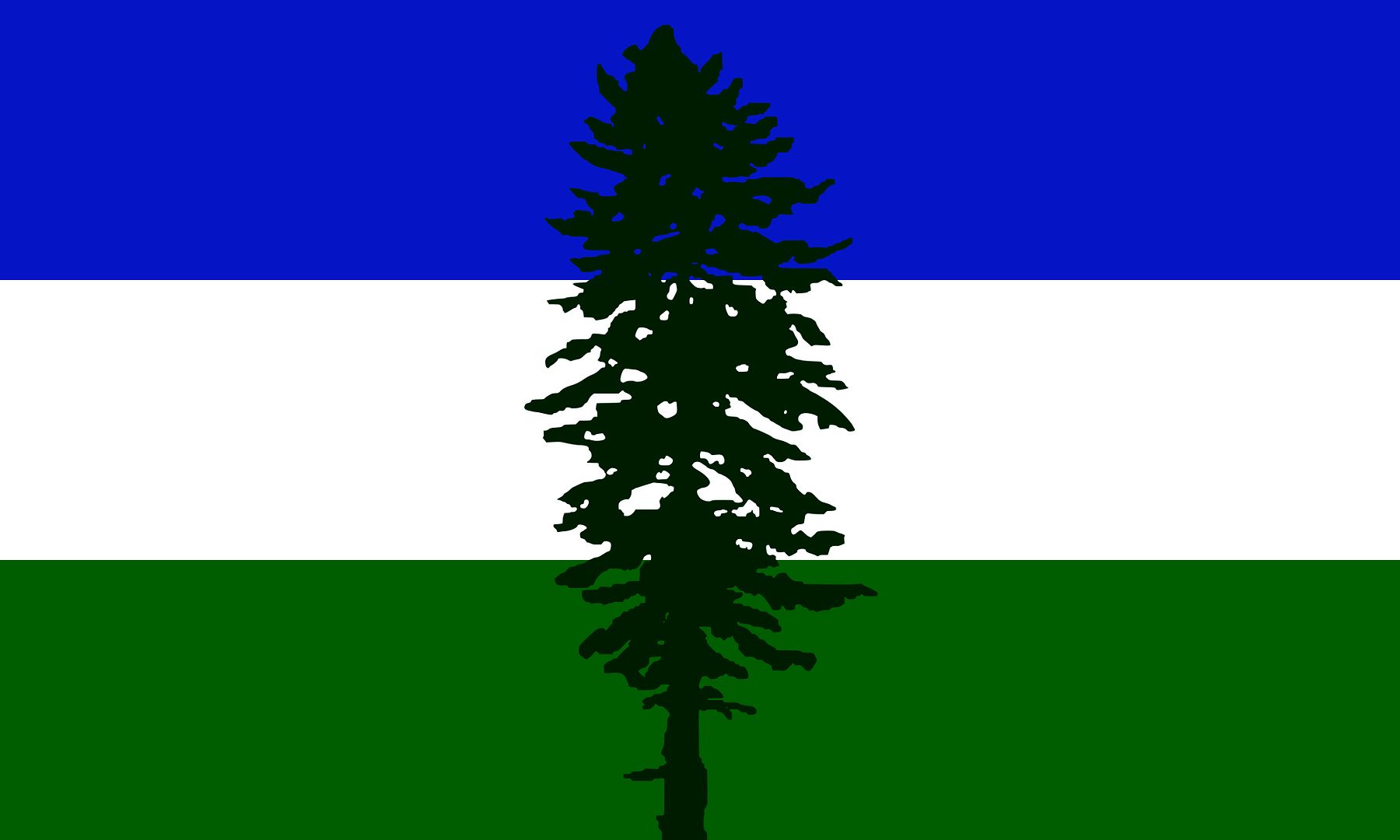
“My view of secession is, it’s bullshit,” flag creator Baretich tells me on the phone from his native Portland as he walks on an overpass that, he notes, is covered in Doug stickers. “I get mad at Brandon because he keeps using the word ‘nation.’ Cascadia is not a nation; it is a bioregion with many indigenous nations within it that we need to respect and honor. If we call ourselves a nation—we’re spitting on Chinook and Duwamish nations who are not federally recognized right now—we’d just be creating another mini-U.S. We really need to get back to our bioregional roots in the Cascadian movement right now.” [Editors Note: Since publication, Letsinger has denied using the word “nation” personally or in CascadiaNow contexts.]
Baretich did not design the Doug flag as a symbol for an independent Cascadian nation, but for the Cascadian bioregion. A bioregion, in strict natural-science terms, is an area defined by its interconnected ecological, geographical, climate, and hydrologic systems—in other words, mountains, watersheds, flora, and fauna. As its name implies, the Cascadian bioregion is demarcated by the Cascade range from northern California all the way up through Washington, including most of Oregon and British Columbia as well as the Pacific Ocean, the Columbia Basin, and the Fraser River watershed, which pushes the bioregion’s borders into the southern Yukon and the tail of Alaska; most of Idaho, the western edges of Wyoming and Montana, and a sliver of northern Nevada. Its shape is quite a bit different than the theoretical Cascadian nation, as a bioregion’s reach has nothing to do with arbitrary political borders. In 1970, Seattle University sociology professor David McCloskey adapted the word Cascadia to posit that, given that humans are also part of ecological systems, the word could also be used to describe a certain sociocultural and ideological unity and identity that naturally emerges from this bioregion—or in simpler terms, the idea that this distinct region breeds a distinct culture. This is something that, judging by all the Cascadian flag profile pictures on Facebook, many Northwesterners alienated by the rhetoric of Donald Trump and, yes, Hillary Clinton too, seem to be feeling deeply.

But bioregionalism, a paradigm that emerged in its modern form in California in the ’70s and immediately flourished in the Northwest, takes all this one step further. “Cascadian bioregionalism, it’s a spiritual thing for me,” says Robert Izatt, a Portland-based member of the Chinook tribe who, like his friend Baretich, believes secessionists are misguided and missing the point. “It’s like a slave asking their master to ‘Please let me go’,” he says. “That’s not how it works.”
For both Izatt and Baretich, Cascadian bioregionalism is above all a consciousness, one rooted in water. “Water is everything. A Cascadian would be one who is fully aware of their bioregion as a living space and their biotic communities and the elemental forces within that community—forces like water,” Baretich says. “And, the most important part, realizing that humans aren’t somehow apart from these life systems, but a part of these systems. Once you’re fully conscious of that—‘I already live here, I am already a part of all of this, and my life depends on these relationships’—then you have to take action, because the dominant culture of corporate capitalist consumerism is in opposition to that; it becomes about resistance.” Bioregionalism stands separate from environmentalism and conservationism in that it is not reactive—“Oh no, we destroyed the whales and the forest, now we have to save them and fence this land off,” Baretich says—but proactive.
Bioregionalism immediately made sense to Izatt once he delved into the philosophy. “It just fit with the classic ways the Chinook tribe understands the world,” Izatt says. “The Chinook see the Earth as a mother. Bioregionalism, that’s really what it’s implying. We all come from the Earth; we have to take care of it and treat it like your mother. Living with the Earth instead of separate from it.”
Izatt hopes to be a bridge between bioregionalists and indigenous communities, and, in his position on the Chinook Natural Resources committee, has attempted to do that by writing bioregional language into his proposed vision statement draft for the organization. “I totally see overlap with bioregionalism and current indigenous resistance,” Izatt says, referencing the credos “Water Is Life” from Standing Rock and “Protect the Sacred” from indigenous activist group Idle No More. “The indigenous people have always seen water as the energy of life; bioregionalism sees water that way too.”
Like any adherents of a philosophy, bioregionalists don’t all fit in one neat box, but some very fundamental, unifying ideas emerge from this basic bioregional consciousness that connect the dots of culture, ecology, and politics.
Decolonization is one of the first key components of any bioregional perspective. “I think people hear that word and hear ‘All whiteys go home,’ ” Baretich says, “but that’s not what decolonization does. It’s about solidarity with the people that were here first; it’s about acknowledging imperialism and what’s happened in our history; it’s about honoring place-based indigenous knowledge, building new communities in accordance with all of that, and deconstructing the view that the Earth is property.”
In the Northwest there have already been a few major steps toward decolonization: removing the Elwha dam; officially renaming Puget Sound, the Strait of Juan de Fuca, and the Strait of Georgia as the Salish Sea; changing Columbus Day to Indigenous Peoples Day; new efforts to restore and teach native languages like Lushootseed and Chinook Jargon; and the 2015 Washington law mandating that tribal history be taught in public schools.
“I would say decolonization is a really important framework from which to address anything,” says Elona Trogub, a board member of the Cascadia Education Project and an organic farmer currently homesteading in rural Cascadia. “It means giving women and indigenous people priority at the table. What does it look like to put the people who were here first a place at the table? What does it look like to put the Earth first at the table? These are the questions that arise when you use decolonization as a framework for your political order.” Decolonization is a dramatic step away from the brash nationalism of Donald Trump.
Ultimately though, Baretich says, decolonization “is about undoing the internalized colonization of our minds that’s happened through capitalism and consumerism.”
Reinhabitation, the second major unifying theory of bioregionalism, stems from this latter idea, one neatly summed up in a 1970 IO magazine interview with one of bioregionalism’s early thinkers, poet, essayist, and activist Gary Snyder. “People have to learn a sense of region, and what is possible within a region, rather than indefinitely assuming that a kind of promiscuous distribution of goods and long-range transportation is always going to be possible.” Reinhabitation posits that human cultures must return to a sustainable economic system and responsible rate of resource extraction that acknowledges the realities and carrying capacities of our bioregions. This idea inherently stands in opposition to neoliberal globalist policies like those promoted by Hillary Clinton, and calls for a return to local economies as well as regionally sourced goods and distribution, something Trogub hopes could offer a bridge between urban and rural demographics. Permaculture, or “permanent agriculture”—an agricultural and social design system developed by Australian bioregional academics Bill Mollison and David Holmgren in 1978—is also a vital part of reinhabitation, which Mollison described as “a philosophy of working with rather than against nature; of protracted and thoughtful observation rather than protracted and thoughtless labor; and of looking at plants and animals in all their functions, rather than treating any area as a single product system.”
“People with European ancestry need to reinhabit the land,” Izatt says. “It’s responsible living—taking only what you need, not just taking it because you can, you want it, or want to sell it.”
Neither Trump, Clinton, nor the majority of politicians operating in the United States’ contemporary liberal/conservative dualism could be considered bioregionalists in any sense. Bioregionalism, with its place-based paradigm of interconnectedness—rooted in enhancing and sustaining life systems rather than systems that prioritize money, profit, and boundless free trade—offers a dramatic philosophical break for Americans (and any global citizens) dissatisfied with the entrenched political culture, one that, judging by pre-election favorability polls, bred two of the most unpopular presidential candidates of our lifetime. The hope for bioregionalists: No matter what your political beliefs, one thing most humans can agree on is that life isn’t possible without water.
But bioregionalism as a tangible political praxis or movement is still mostly a blank slate. But it is one that interested Cascadians will have a chance to discuss in person during open Cascadia planning meetings in Seattle and Portland this Saturday, with more meetings planned in smaller cities across the region on November 27. “I think the immediate need is vision, values and goal,” Trogub says, “and from there, we can decide on strategies and tactics. Without any cohesive statement, we’ll continue having essential questions that need to be addressed immediately. Our actions can then follow from those written-down values.”
If you’re planning on attending the two-hour meeting, just make sure to bring some water. That stuff is important. Seattle Cascadia Planning Meeting, 407 Second Ave. S., yescascadia.org. Free. All ages. 6–8 p.m. Sat., Nov. 19.
ksears@seattleweekly.com
